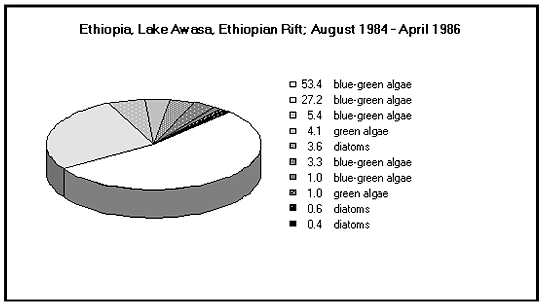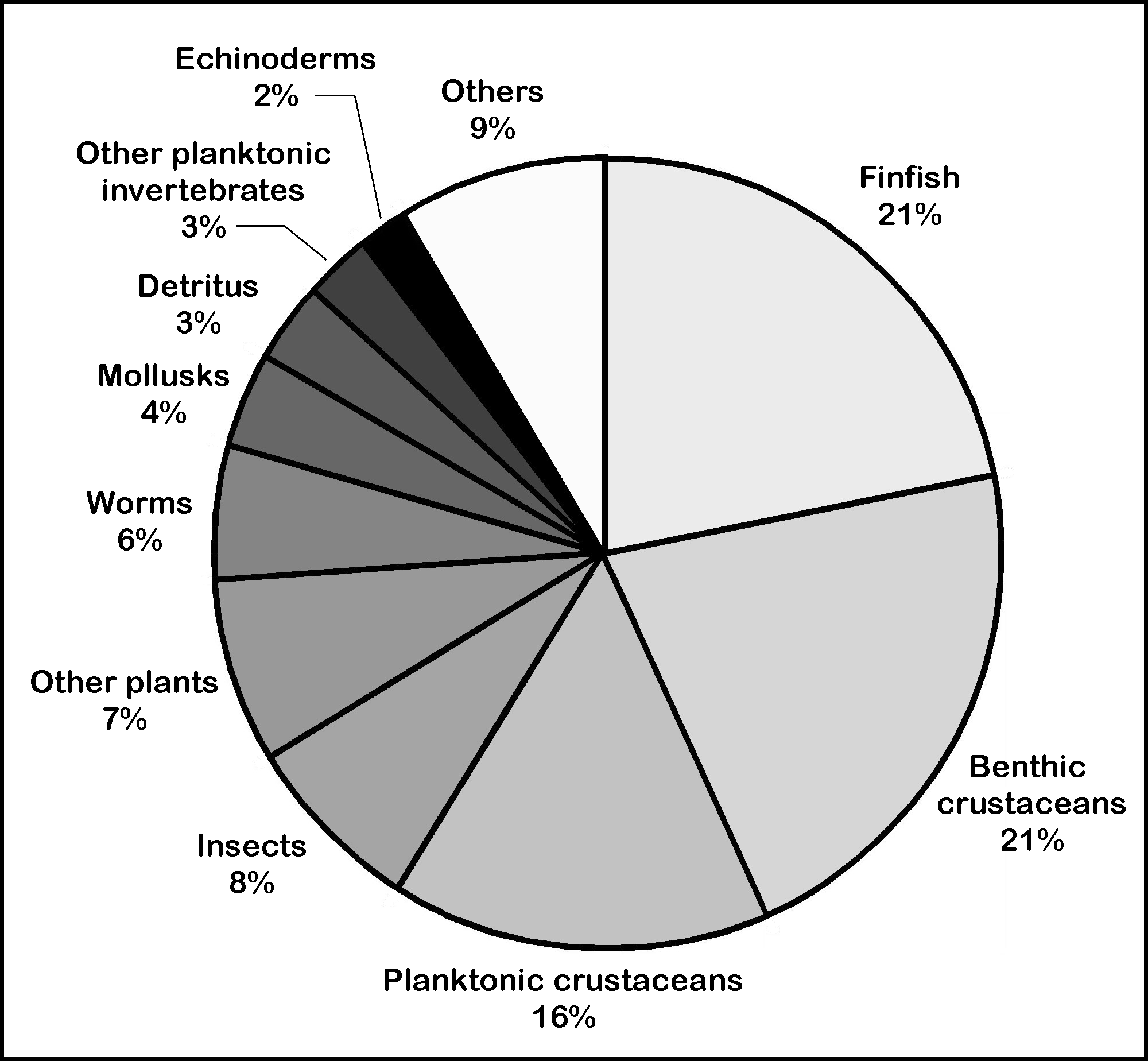|
Functional group (I) |
Median (%) |
Functional group (II) |
Median (%) |
Min. (%) |
Max. (%) |
Records |
|
Detritus |
57 |
Detritus |
57 |
25.4 |
100 |
82 |
|
Plants |
64 |
Phytoplankton |
53 |
26.8 |
100 |
43 |
|
Other plants |
65 |
18.3 |
100 |
179 |
||
|
Zooplankton |
60 |
Fish (early stages) |
55 |
22.5 |
100 |
25 |
|
Planktonic crustaceans |
60 |
18.5 |
100 |
376 |
||
|
Other planktonic invertebrates |
60 |
19.8 |
100 |
66 |
||
|
Zoobenthos |
52 |
Benthic crustaceans |
53 |
18.6 |
100 |
514 |
|
Cnidarians |
70 |
29.0 |
100 |
38 |
||
|
Echinoderms |
47 |
16.5 |
100 |
46 |
||
|
Insects |
50 |
15.6 |
100 |
187 |
||
|
Mollusks |
56 |
21.0 |
100 |
93 |
||
|
Sponges and tunicates |
62 |
21.0 |
98.2 |
31 |
||
|
Worms |
50 |
18.9 |
100 |
137 |
||
|
Other benthic invertebrates |
52 |
27.5 |
99.0 |
27 |
||
|
Nekton |
68 |
Cephalopods |
50 |
20.6 |
100 |
40 |
|
Finfish |
69 |
21.5 |
100 |
532 |
|
|
| How to get there |
You get to the DIET table by clicking on the Biology button in the SPECIES window, the Trophic ecology button in the BIOLOGY window and the Diet button in the TROPHIC ECOLOGY window.
You get to the pie chart of diet compositions by locality by double-clicking on the study of interest in the DIET COMPOSITION window, then clicking on the Graph button in the upper right corner of the DIET window.
You get to the troph level vs. maximum length graph by clicking on the left Graph button in the upper right corner of the DIET COMPOSITION window.
You get to the Troph Changes by Length graph by clicking on the right button in the upper right corner of the DIET COMPOSITION window. You are given the option to include results of a regression analysis (line and equation) on this graph.
|
|
| Internet |
On the Internet, you get to the DIET table by clicking on the Diet Composition link in the ‘More information’ section of the ‘Species Summary’ page. You can create a list of all species for which diet data are available by selecting the Diet radio button in the ‘Information by Topic’ section of the ‘Search FishBase’ page.
|
|
| References |
Armstrong, M.J. 1982. The predator-prey relationships of Irish Sea poor-cod (Trisopterus minutus L.), pouting (Trisopterus luscus L.), and cod (Gadus morhua L.). J. Cons. CIEM 40:135-152. Barnes, R.D. 1980. Invertebrate zoology. 4th ed. JMC Press, Inc., Quezon City, Philippines. 1089 p. de Groot, S.J. 1984. Dutch observations on rare fish and Crustacea in 1981. Annales Biologiques (Copenhagen) 38:206. de Luca, F. 1988. Taxonomic authority list. Aquatic Sciences and Fisheries Information System Ref. Ser. No. 8, 465 p. Gonzalez, G.D. and L.A. Soto. 1988. Hábitos alimentícios de peces de depredadores del sistema lagunar Huizache-Caimanero, Sinaloa, México. Inst. Cienc. Del Mar y Limnol. Univ. Nal. Autón. México 15(1):97-124. Hardy, J.D. 1993. NODC taxonomic code links biology and computerized data processing. Earth System Monitor 4(2):1-2. Hobson, E.S. 1974. Feeding relationships of teleostean fishes on coral reefs in Kona, Hawaii. Fish. Bull. 72(4):915-1031. Laroche, J.L. 1982. Trophic patterns among larvae of five species of sculpins (Family: Cottidae) in a Maine estuary. Fish. Bull. 80(4):827-840. Randall, J.E. 1967. Food habits of reef fishes of the West Indies. Stud. Trop. Oceanogr. Miami 5:665-847. Randall, J.E. 1985. Guide to Hawaiian reef fishes. Harrowood Books, Newton Square, Pensylvania. Sano, M., M. Shimizu and Y. Nose. 1984. Food habits of teleostean reef fishes in Okinawa Island, southern Japan. University of Tokyo Press, Tokyo, Japan. 128 p. Sierra, L.M., R. Claro and O.A. Popova. 1994. Alimentacion y relaciones tróficas, p. 263-284. In R. Claro (ed.) Ecología de los Peces Marinos de Cuba. Instituto de Oceanología Academia de Ciencias de Cuba / Centro de Investigaciones de Quintana Roo, México. Stevens, D.E. 1966. Food habits of striped bass, Roccus saxatilis in the Sacramento-San Joaquin Delta, p. 68-96. In J.L. Turner and D.W. Kelly (comps.) Ecological studies of the Sacramento-San Joaquin Delta. Part II. Fishes of the Delta. Fish. Bull. 136. Tiews, K., S.A. Bravo, I.A. Ronquillo and J. Marques. 1972. On the food and feeding habits of eight species of Leiognathus found in Manila Bay and San Miguel Bay. Indo-Pac. Fish. Counc. 13(3):93-99. Valtysson, H.T. 1995. Feeding habits and distribution of eelpout species Lycodes spp. (Reinhardt) (Pisces: Zoarcidae) in Icelandic waters. Department of Biology, University of Iceland, Reykjavik. Postgraduate thesis. Maria Lourdes D. Palomares and Pascualita Sa-a |
|

